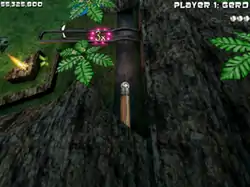Adventure Pinball: Forgotten Island
Adventure Pinball: Forgotten Island is a pinball video game released in 2001 by Electronic Arts for Microsoft Windows.[1]
| Adventure Pinball: Forgotten Island | |
|---|---|
 | |
| Developer(s) | Digital Extremes |
| Publisher(s) | Electronic Arts |
| Engine | Unreal Engine |
| Platform(s) | Microsoft Windows |
| Release |
|
| Genre(s) | Pinball |
| Mode(s) | Single-player, multiplayer |
Gameplay

The game uses the Unreal engine[2] which was previously only used for first-person shooter games. It provided a fresh new gameplay experience for its time, especially in the aspect of pinball games. The game is rendered in 3-D and has both a story mode consisting of 9 levels, where no actual pinball tables exist and a table mode. Most of the levels must be unlocked by completing other levels. There are hidden areas in the story mode to earn bonus points, it also features special power-ups to help the player's progression through the game.

The game was unlike any other pinball game at the time, it was not just an average game of pinball behind a glass case or a video game simulation, players were able to roam around a small world known as The Forgotten Island. It also featured monsters and insects to eliminate or bypass while playing in story mode. It is known at times for being a very fast-paced game.[3]

In addition to the instruction manual, a booklet is provided with the Windows version of the game that includes a short story in the appearance of the main character's personal journal. It hints of a possible sequel at the end of the story by saying "I have the feeling there's more adventure to come", but this has not been confirmed or announced yet.
Levels
The levels for story mode and table mode are the same, but the difference is story mode offers quests and objectives to unlock new levels for both story mode and table mode, as opposed to table mode which is used to set a high score for each level.
Development
The game went gold on March 6, 2001.[2]
Reception
| Aggregator | Score |
|---|---|
| GameRankings | 63.56%[1] |
| Metacritic | 60/100[4] |
| Publication | Score |
|---|---|
| GameSpot | 6.6/10[5] |
| IGN | 6.7/10[6] |
| Next Generation |
Adventure Pinball: Forgotten Island received mixed reviews from critics. It maintains a 63,56% rating on GameRankings based on 10 reviews.[1] Trey Walker of GameSpot rated the game 6.6 of 10 saying "While it has its faults, it is for the most part successful in adding first-person shooter flash to a traditional kind of game".[5]
IGN rated the game 6.7 of 10 saying "It's one of the few times where I would have liked less levels, with more quality construction".[6]
Jeff Lundrigan reviewed the PC version of the game for Next Generation, rating it two stars out of five, and stated that "Sonic Spinball did this sort of thing much better – without resorting to high-tech 3D engines – over eight years ago."[7]
References
- "Adventure Pinball: Forgotten Island Reviews". GameRankings. CBS Interactive. Retrieved October 1, 2019.
- IGN Staff (March 6, 2001). "News Briefs". IGN. Ziff Davis. Retrieved October 1, 2019.
- "CNET Review". CNET. Retrieved 2009-03-04.
- "Adventure Pinball: Forgotten Island Reviews". Metacritic. CBS Interactive. Retrieved October 1, 2019.
- Walker, Trey (March 22, 2001). "Adventure Pinball: Forgotten Island Review". GameSpot. CBS Interactive. Archived from the original on October 9, 2012. Retrieved October 1, 2019.
- Lopez, Vincent (March 29, 2001). "Adventure Pinball: Forgotten Island Review". IGN. Ziff Davis. Retrieved October 1, 2019.
- Lundrigan, Jeff (June 2001). "Finals". Next Generation. Vol. 4 no. 6. Imagine Media. p. 88.